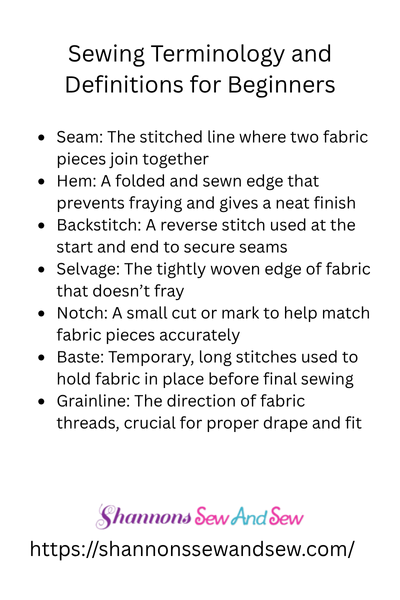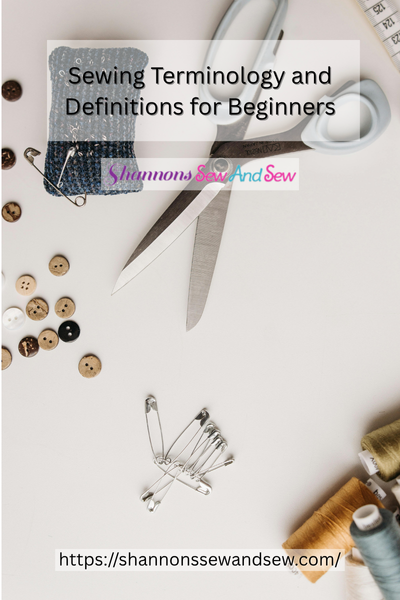Sewing For Beginners
Sewing Terminology and Definitions for Beginners
Sewing terminology and definitions for beginners can feel like decoding some kind of secret language, right? You sit down with a pattern, full of good intentions, and suddenly you’re face-to-face with words like “selvage,” “baste,” and “grainline.” Wait—what? If you’ve ever paused mid-project to Google a sewing term, you’re definitely not alone.
When I first started sewing, I was convinced I’d accidentally stumbled into a class meant for textile engineers. I remember staring at the back of a pattern envelope like it was written in Klingon. And don’t even get me started on trying to figure out what a “notch” was—I thought maybe it had something to do with tree bark. Spoiler alert: it doesn’t.
But here’s the thing: once you start picking up sewing terminology and definitions for beginners, it all begins to click. Suddenly, those weird words become useful tools. It’s like learning to drive. At first, there’s too much going on—pedals, mirrors, turn signals—but then one day, you’re cruising with one hand on the wheel and a coffee in the other.
Read More About Sewing Terminology and Definitions for Beginners

Why Knowing Sewing Terms Matters (More Than You Think)
Let’s be real: if you’re learning to sew, whether you’re making your own clothes, repairing a rip, or just having fun with fabric, the last thing you want is to be held back by confusing lingo. Understanding sewing terminology and definitions for beginners saves time, reduces mistakes, and honestly, makes the whole experience a lot more fun.
Imagine trying to assemble IKEA furniture without knowing what a “dowel” is. Sewing’s kind of the same—only instead of a lopsided shelf, you end up with a very creative (but unwearable) garment.
More Things to Know About Sewing Terminology and Definitions for Beginners

Common Terms You’ll Actually Use
Okay, let’s cut through the fluff. Here are a few of the most useful terms you’ll run into as a beginner—and why they matter:
Seam Allowance – This is the space between the edge of your fabric and the stitching line. It’s like a little buffer zone. Most patterns assume a ⅝” seam allowance unless they say otherwise.
Right Side/Wrong Side – Not a moral judgment, I promise! The “right side” is the side of the fabric you want people to see. The “wrong side” is the back. Mixing them up can turn your nice shirt into a fashion mystery.
Selvage – This one sounds fancy, but it just refers to the tightly woven edge of the fabric that won’t fray. It helps you figure out which way the fabric runs.
Grainline – Speaking of which, the grainline runs parallel to the selvage. Patterns usually tell you to place them along the grainline for the best fit and drape.
Basting – This is like the sewing version of a test run. Basting stitches are long, temporary stitches that hold things in place. I use basting anytime I’m unsure about a fit—or feeling commitment issues.
Notches – These little triangle-shaped cuts (or marks) help you line up pieces accurately. Think of them like puzzle piece indicators.
Once you start to understand these basic sewing terminology and definitions for beginners, you can approach patterns with way more confidence—and less confusion. You might even start to feel… dare I say… like a sewing ninja.
Real Talk: You’ll Still Google Stuff (And That’s Okay)
Even after years of sewing, I still double-check certain terms. You don’t have to memorize every word in the sewing dictionary to be good at this. The goal isn’t to become a walking glossary—it’s to feel confident enough to make something awesome. So if you need to look up “interfacing” for the third time this week, no judgment here.
And while we’re on the topic—interfacing is that extra layer that gives structure to parts of your project, like collars or waistbands. See? Told you it’s worth knowing this stuff.
A Few Laughs Along the Way
I once stitched an entire waistband to the wrong side of my pants. Didn’t even realize until I tried them on and thought, “Why is the nice part on the inside?” Answer: because I ignored the “right side” label. So yeah, these little definitions? They save you from a lot of creative disasters.
And hey, part of the fun in sewing is messing up sometimes. It’s how you learn. Every wonky seam has a story—and usually a chuckle attached.
Talk the Talk: Sewing Terms Every Beginner Should Know
Getting comfortable with sewing terminology and definitions for beginners is like giving yourself a backstage pass to the world of sewing. You start to understand patterns faster, fix mistakes easier, and most importantly—enjoy the process more.
If you’re just starting out, don’t worry if it feels overwhelming. Stick with it. Before you know it, you’ll be talking about darts, pleats, and zippers like you’ve been doing it forever. And hey, when you finally nail your first project? You’ll be glad you took the time to learn the lingo.
So grab that pattern, pick your fabric, and don’t let the weird words stop you. You’ve got this—and I’m cheering you on every stitch of the way.




















